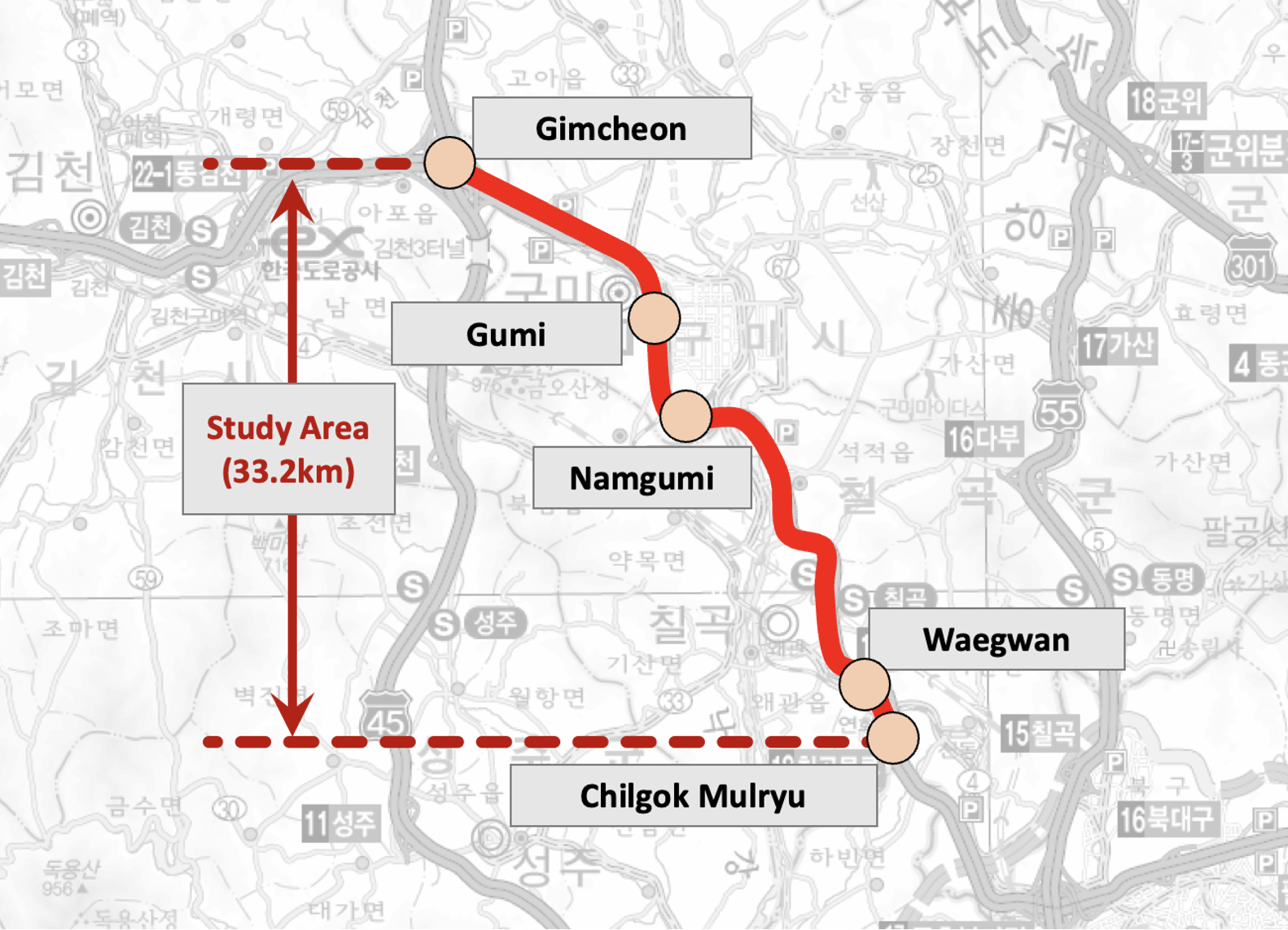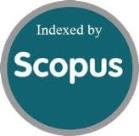Assessing the Effectiveness of Exclusive Truck Lanes: A Korean Expressways Case Study
DOI:
https://doi.org/10.46604/aiti.2024.14507Keywords:
exclusive truck lane, simulation, VISSIM, travel speed, speed standard deviationAbstract
This study investigates the operational and safety impacts of introducing exclusive truck lanes on the Gyeongbu Expressway in South Korea, addressing the necessity of such lanes due to the disparities in vehicle weight and performance between trucks and passenger cars. The study focused on the 33.2 km, one-way, four-lane Chilgok-Mulryu to Gimcheon segment, adhering to international installation criteria. Using the micro-simulation tool VISSIM, the rightmost lane was modeled as exclusive for trucks, and traffic operations and safety were analyzed under varying conditions of Level of Service (LOS). Under LOS C, the exclusive truck lane reduced the speed standard deviation (a surrogate safety measure) with minimal travel speed reduction. Conversely, under LOS A with low traffic, average travel speed declined, and speed standard deviation increased due to limited truck usage. These findings highlight the need for flexible truck lane management tailored to traffic and road conditions.
References
G. Rempel, J. Montufar, J. Regehr, A. Clayton, and D. Middleton, “Truck Lanes in Canadian Urban Areas: Resource Document,” Transportation Association of Canada, Ottawa, ON, Technical Report, 2014.
S. L. Reich, J. L. Davis, M. Catalá, and A. J. Ferraro, “The Potential for Reserved Truck Lanes and Truckways in Florida,” Center for Urban Transportation Research, University of South Florida, Florida, Technical Report, 2005.
“M1 Truck Lane Restrictions,” https://www.tmr.qld.gov.au/business-industry/Heavy-vehicles/M1-truck-lane-restrictions, accessed in 2024.
“Priority Lane FAQs,” https://www.nzta.govt.nz/roads-and-rail/ramp-signals/priority-lane-faqs/, accessed in 2024.
H. C. Chu and M. D. Meyer, “Screening Process for Identifying Potential Truck-Only Toll Lanes in a Metropolitan Area: The Atlanta, Georgia, Case,” Transportation Research Record, vol. 2066, no. 1, pp. 79-89, 2008.
M. J. Fischer, D. N. Ahanotu, and J. M. Waliszewski, “Planning Truck-Only Lanes: Emerging Lessons from the Southern California Experience,” Transportation Research Record, vol. 1833, no. 1, pp. 73-78, 2003.
M. A. Cate and T. Urbanik, “Another View of Truck Lane Restrictions,” Transportation Research Record, vol. 1867, no. 1, pp. 19-24, 2004.
J. Mwakalonge and R. Moses, “Evaluation of Truck Lane Restriction on Non-limited Access Urban Arterials,” International Journal of Transportation Science and Technology, vol. 1, no. 2, pp. 191-204, 2012.
S. El-Tantawy, S. Djavadian, M. J. Roorda, and B. Abdulhai, “Safety Evaluation of Truck Lane Restriction Strategies Using Microsimulation Modeling,” Transportation Research Record, vol. 2099, no. 1, pp. 123-131, 2009.
M. D. Fontaine and K. B. Torrance, “Evaluation of Truck Lane Restrictions in Virginia,” Virginia Transportation Research Council, Charlottesville, Technical Report 07-CR11, 2007.
D. Borchardt, D. Jasek, and A. Ballard, “Monitoring of Texas Vehicle Lane Restrictions,” Texas Transportation Institute, College Station, Texas, Technical Report FHWA/TX-05/0-4761-1, 2004.
D. Kobelo, V. Patrangenaru, and R. Moses, “Safety Analysis of Florida Urban Limited Access Highways with Special Focus on the Influence of Truck Lane Restriction Policy,” Journal of Transportation Engineering, vol. 134, no. 7, pp. 297-306, 2008.
H. Yang, K. Ozbay, and K. Xie, “Impact of Truck-Auto Separation on Crash Severity,” Proceedings of the 94th Annual Meeting of the Transportation Research Board, Washington, D.C., 2015.
S. Das, M. Le, M. P. Pratt, and C. Morgan, “Safety Effectiveness of Truck Lane Restrictions: A Case Study on Texas Urban Corridors,” International Journal of Urban Sciences, vol. 24, no. 1, pp. 35-49, 2020.
Federal Highway Administration, “Longer Combination Vehicles on Exclusive Truck Lanes: Interstate 90 Case Study,” U.S. Department of Transportation, Washington, D.C., Technical Report, 2009.
S. Ishak, B. Wolshon, X. Sun, M. Korkut, and Y. Qi, “Evaluation of the Traffic Safety Benefits of a Lower Speed Limit and Restriction of Trucks to Use of Right Lane Only on I-10 over the Atchafalaya Basin,” Department of Civil and Environmental Engineering, University of Louisiana at Lafayette, Technical Report FHWA/LA.08/435, 2012.
J. Shi, T. Bai, Z. Zhao, and H. Tan, “Driving Economic Growth through Transportation Infrastructure: An In-Depth Spatial Econometric Analysis,” Sustainability, vol. 16, no. 10, article no. 4283, 2024.
A. M. Rivadeneira, J. Benavente, and A. Monzon, “Efficient Operation of Metropolitan Corridors: Pivotal Role of Lane Management Strategies,” Future Transportation, vol. 4, no. 3, pp. 1100-1120, 2024.
C. W. Jeong, “A Study on the Accident Reduction Effectiveness of Lane Designation,” Public Security Policy Research, vol. 22, pp. 27-51, 2008.
User Guide: VDOT VISSIM, Vers. 2.0, Virginia Department of Transportation, 2020.
“Vissim Calibration Parameters_03-30-21.xlsx,” https://wisconsindot.gov/dtsdManuals/traffic-ops/manuals-and-standards/teops/16-20att6.3.pdf, 2021.
N. J. Garber and R. Gadiraju, “Speed Variance and its Influence on Accidents,” AAA Foundation for Traffic Safety, Washington, D.C., Technical Report ED 312 438/CE 053 521, 1988.
Z. Zheng, S. Ahn, and C. M. Monsere, “Impact of Traffic Oscillations on Freeway Crash Occurrences,” Accident Analysis and Prevention, vol. 42, no. 2, pp. 626-636, 2010.

Published
How to Cite
Issue
Section
License
Copyright (c) 2025 Kiyoung Lee, Hyunjin Park, Seongkwan Mark Lee

This work is licensed under a Creative Commons Attribution-NonCommercial 4.0 International License.
Submission of a manuscript implies: that the work described has not been published before that it is not under consideration for publication elsewhere; that if and when the manuscript is accepted for publication. Authors can retain copyright in their articles with no restrictions. is accepted for publication. Authors can retain copyright of their article with no restrictions.
Since Jan. 01, 2019, AITI will publish new articles with Creative Commons Attribution Non-Commercial License, under The Creative Commons Attribution Non-Commercial 4.0 International (CC BY-NC 4.0) License.
The Creative Commons Attribution Non-Commercial (CC-BY-NC) License permits use, distribution and reproduction in any medium, provided the original work is properly cited and is not used for commercial purposes.







